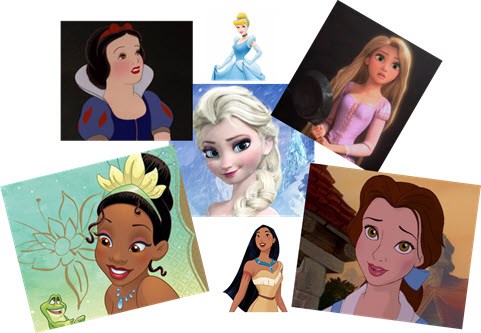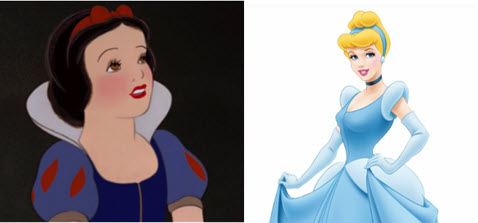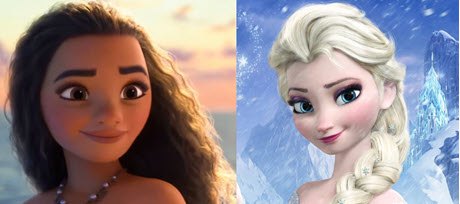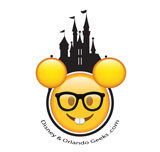In the enchanting realm of Disney, the evolution of Disney princesses has been a captivating journey, mirroring the ever-changing landscape of contemporary media.
As we embark on this exploration, it is crucial to understand the significance of Disney Princesses in shaping societal perceptions and expectations.
These iconic characters have transcended mere animated figures, becoming cultural touchstones that reflect and influence the evolving narratives of their times.

From the classic fairy tales that laid the foundation to the modern narratives that challenge stereotypes, Disney Princesses have undergone a remarkable transformation.
This metamorphosis is not just a visual journey but a reflection of societal shifts, pushing boundaries and redefining the roles of women in popular culture.
The evolution of Disney Princesses is more than a chronological progression; it symbolizes a dynamic response to changing societal norms.
These characters are not static; they are cultural barometers, influencing and being influenced by the world around them.
Their evolution reflects Disney’s adaptability in addressing diverse audience expectations and societal values.
This article will unfold in a chronological exploration, delving into the various eras of Disney Princesses.
We’ll journey from the pioneering days of Snow White and Cinderella to the empowered narratives of characters like Elsa and Moana.
Along the way, we’ll examine the societal and cultural influences that shaped these characters, exploring controversies, criticisms, and the promising trends that pave the way for a more inclusive and progressive future for Disney Princess storytelling.
Let’s embark on this magical odyssey through time and tales.
The Dawn of Disney: Snow White and Cinderella
In the golden age of animation, Walt Disney introduced audiences to the enchanting world of princesses with the timeless classics, Snow White and Cinderella.

These pioneering characters set the stage for the Disney Princess legacy, captivating hearts and laying the foundation for animated storytelling.
Snow White, gracing the screen in 1937, was the first Disney Princess, a trailblazer in the realm of animated storytelling.
Her gentle demeanour and enduring optimism left an indelible mark on audiences. Cinderella, following in 1950, continued this legacy with her grace and resilience, reinforcing the archetype of the fairy-tale princess.
The early Disney Princesses reflected the prevailing norms of their time, embodying traditional femininity and often finding their narratives centered around romance and matrimony.
Snow White and Cinderella became iconic representations of grace and virtue, aligning with societal expectations prevalent during the mid-20th century.
The creation of Snow White and Cinderella was deeply influenced by the socio-cultural climate of their respective periods.
In the 1930s and 1950s, societal expectations for women were anchored in domesticity, and these princesses mirrored those ideals.
The stories were crafted against a backdrop where traditional gender roles were deeply ingrained, shaping the characters into aspirational figures within the constraints of those expectations.
As we traverse through the next stages of Disney’s narrative evolution, we witness the subtle yet profound shifts that steer away from these conventional moulds, ushering in a new era of Disney Princesses.
The journey unfolds, and the characters evolve, transcending the limitations of their origins.
A Shift in Narrative: From Damsels to Warriors
As the calendar flipped to the 1990s, a notable metamorphosis occurred in the world of Disney Princesses.
The narrative arc shifted from traditional damsels in distress to resilient, independent women who embarked on journeys of self-discovery and empowerment.
This era marked a turning point in Disney’s storytelling, introducing characters who shattered stereotypes and embraced their destinies with courage and determination.
The 1990s witnessed a departure from the passive princess archetype, giving rise to dynamic characters who were not defined solely by their romantic pursuits.
This era marked a conscious effort by Disney to adapt its narratives to reflect the changing expectations of its audience, particularly with regards to the portrayal of women.
Enter a new breed of Disney Princesses, heralding a paradigm shift. Characters like Belle, Pocahontas, and Mulan took center stage, each with a unique story that emphasized intelligence, bravery, and a fierce determination to chart their own destinies.
These heroines became catalysts for a generation of viewers who sought more nuanced and empowering narratives.

- Belle: Debuted in 1991’s “Beauty and the Beast,” Belle defied societal norms by valuing intellect over appearance. Her love for reading and independent spirit challenged the conventions of her provincial town, setting a precedent for future princesses.
- Pocahontas: Released in 1995, Pocahontas broke new ground by portraying a Native American princess who defied cultural barriers. Her connection with nature and her courage in the face of adversity elevated her character beyond the conventional princess mold.
- Mulan: 1998’s “Mulan” featured a courageous young woman who disguised herself as a man to take her ailing father’s place in the army. Mulan’s journey was one of self-discovery, courage, and breaking gender norms, showcasing a different facet of heroism.
These characters not only entertained but also paved the way for a more diverse and dynamic representation of women in animated storytelling.
The winds of change continued to blow through the Disney Princess landscape, ushering in an era where the strength of character mattered as much as the magic of the fairy tale.
Unconventional Princesses: Breaking the Mould
As the 2000s unfolded, Disney embarked on a courageous journey, steering away from conventional princess tropes to introduce characters who defied stereotypes and shattered traditional narratives.
This marked a new chapter in the evolution of Disney Princesses, embracing diversity and individuality in unprecedented ways.
In the late 2000s, Disney took a bold step forward, recognizing the need for more diverse and relatable princesses.
This shift represented a commitment to reflect a broader spectrum of stories and perspectives, resonating with an audience hungry for narratives that transcended the confines of fairy-tale conventions.
The introduction of non-traditional princesses had a profound impact on both audiences and the broader media landscape.
Viewers connected with characters who, while still magical, faced challenges that mirrored real-world struggles.
This evolution not only enriched the storytelling experience but also contributed to a more inclusive and reflective entertainment landscape.
- Tiana (The Princess and the Frog – 2009): Tiana, Disney’s first African-American princess, shattered racial barriers. Her story, set in 1920s New Orleans, emphasized hard work and ambition, showcasing a different path to achieving dreams. Tiana’s resilience and determination resonated with audiences, contributing to a more diverse representation of princesses.
- Rapunzel (Tangled – 2010): Rapunzel, known for her long magical hair, represented a departure from the traditional damsel in distress. Her adventurous spirit, artistic talent, and eagerness to explore the world made her a relatable and dynamic character. Tangled’s success highlighted the audience’s appetite for unconventional narratives.
- Merida (Brave – 2012): Merida, the flame-haired Scottish princess, challenged the notion of arranged marriages and defied gender norms. Her archery skills and desire for autonomy showcased a fierce independence that resonated with viewers. Brave marked a significant departure from the classic fairy-tale formula, emphasizing the importance of self-discovery.

These princesses not only expanded the narrative possibilities within the Disney Princess canon but also contributed to a cultural shift, inspiring audiences to embrace individuality and diversity.
The stage was set for a new era of Disney Princesses, where each character brought a unique story to the forefront, enriching the tapestry of animated storytelling.
The Age of Empowerment: Elsa and Moana
As we transition into the modern era of Disney Princesses, two iconic characters, Elsa and Moana, stand as beacons of empowerment, representing a profound evolution in the portrayal of strength, autonomy, and self-discovery.
Elsa and Moana emerged as catalysts for change in the portrayal of power dynamics within Disney Princess narratives.
Beyond the traditional themes of love and romance, their stories centered on inner strength, resilience, and the empowerment that comes from embracing one’s true self.
These characters shattered preconceived notions, showcasing that power could be wielded responsibly and with a sense of purpose.
Elsa, from “Frozen” (2013), and Moana, from “Moana” (2016), not only brought new dimensions to the Disney Princess archetype but also introduced cultural diversity to their narratives.
Elsa’s journey resonated with themes of self-acceptance and breaking free from societal expectations, while Moana celebrated Polynesian culture, emphasizing the importance of connection to one’s heritage and environment.
The cultural richness embedded in these stories expanded the horizons of Disney storytelling, fostering a deeper appreciation for diverse backgrounds.
Elsa and Moana became powerful role models for young viewers, transcending the confines of a fairy-tale world to impart real-world lessons.
Elsa’s struggle with her ice powers resonated with themes of self-control and acceptance, teaching young audiences about the importance of embracing one’s uniqueness.
Moana’s adventurous spirit and connection to her cultural roots inspired a generation to explore their own identities and appreciate the richness of diverse backgrounds.
These characters not only captivated audiences with their narratives but also played a crucial role in shaping the expectations of young viewers.
Elsa and Moana ushered in an era where Disney Princesses are not just passive recipients of fate but active participants in their own stories, wielding power responsibly and inspiring a new generation to embrace their inner strength.

The legacy of empowerment continues to reverberate through the Disney Princess landscape, setting the stage for more dynamic and impactful characters in the years to come.
Disney’s Princesses and Ethnic Representation
The inclusion of diverse ethnic backgrounds in Disney Princess narratives has been both a source of celebration and a subject of critique.
As we delve into this facet of the Disney Princess evolution, we’ll examine the highs and lows, exploring the impact of ethnic representation on audiences and the broader cultural landscape.
While Disney has made strides in diversifying its line up of princesses, critiques have arisen regarding the authenticity and depth of representation.
Some argue that certain characters may perpetuate stereotypes or fail to fully capture the nuances of the cultures they are meant to represent.
The critique underscores the responsibility on Disney’s part to approach ethnic representation with cultural sensitivity and avoid reducing diverse backgrounds to mere caricatures.
There have been commendable instances of positive ethnic representation in Disney Princess films. Characters like Mulan, Pocahontas, and Moana have been praised for breaking away from traditional moulds, offering audiences stories deeply rooted in their respective cultural contexts.
However, there remains room for improvement, with calls for more authentic storytelling, increased diversity among the creative teams, and a commitment to avoiding cultural appropriation.
The introduction of diverse ethnic backgrounds in Disney Princess narratives has had a profound impact on audiences globally.
It has not only allowed underrepresented communities to see themselves reflected on screen but has also fostered cross-cultural understanding.
Disney films have become cultural ambassadors, introducing viewers to different traditions, values, and perspectives, fostering a sense of empathy and appreciation for the richness of the world’s cultures.
As Disney continues to navigate the delicate balance of representing diverse ethnic backgrounds, it is essential for the company to heed critiques, engage in meaningful dialogue with communities, and prioritize authenticity in storytelling.
The potential for positive change through Disney Princess narratives is vast, offering an opportunity to contribute to a global cultural exchange that goes beyond entertainment, leaving a lasting impact on societal perceptions and understanding.
Controversies and Criticisms: An Analytic Look
In the enchanted world of Disney Princesses, controversies and criticisms have not been strangers.
As we scrutinize the debates that have surrounded these iconic narratives, we unravel the complexities of Disney’s storytelling choices, their responses to critique, and the consequential impact on the evolution of princess narratives.
Disney Princesses, being cultural touchstones, have often found themselves at the center of debates.
Criticisms have ranged from outdated gender roles and depictions of beauty to accusations of cultural insensitivity.
Notable instances include critiques of the passive nature of early princesses, concerns about body image perpetuation, and debates around cultural appropriation in characters like Jasmine and Pocahontas.
These controversies reflect broader societal discussions on representation, identity, and societal expectations.
Disney has responded to these critiques with a dynamic approach over the years. The company has acknowledged past missteps and actively worked towards addressing concerns.
Initiatives such as the creation of more empowered and diverse princesses and showcasing stronger character arcs demonstrate a commitment to evolving with societal expectations.
Moreover, Disney has been responsive to the call for cultural sensitivity, engaging consultants from relevant communities and incorporating authentic voices into the creative process.
The controversies surrounding Disney Princesses have not only shaped the discourse around these characters but have also influenced Disney’s narrative choices.
The shift from traditional princess archetypes to more dynamic, empowered characters can be traced, in part, to the critiques regarding outdated gender norms.
Similarly, the commitment to more authentic cultural representation and storytelling can be seen as a response to the controversies related to cultural insensitivity.
These controversies, instead of stifling creativity, have acted as catalysts for positive change, prompting Disney to re-evaluate its narratives and strive for more inclusive and responsible storytelling.
As we navigate through the nuanced landscape of Disney Princess controversies, it becomes evident that the dialogues sparked by critique have played a crucial role in shaping the evolution of these beloved characters.
Disney’s willingness to engage with criticism and evolve its approach demonstrates the company’s awareness of its cultural influence and a commitment to aligning its narratives with the ever-changing values of its audience.
The interplay between critique and creative response continues to be an integral part of the ongoing journey of Disney Princesses.
The Future of Disney Princesses: Progressive and Inclusive Storytelling
As we gaze into the crystal ball of Disney’s future, it becomes evident that the trajectory of Disney Princesses is poised for even greater innovation and inclusivity.
Drawing inspiration from the rich tapestry of their past evolution, we can anticipate several key trends that will shape the narratives of Disney Princesses in the years to come.
Building on the foundation laid by the progressive evolution of Disney Princesses, we can anticipate a continued departure from traditional stereotypes and a focus on multifaceted characters.
Future princesses may embody diverse identities, backgrounds, and abilities, challenging societal norms and presenting narratives that resonate with an increasingly global and diverse audience.
The trend of empowerment, self-discovery, and resilience is likely to persist, with characters navigating complex and relatable challenges.
The demand for authentic representation and diversity is a driving force shaping the future of Disney Princesses.
Audiences are increasingly vocal about the need for characters that reflect their own diverse experiences.
Disney is likely to respond by introducing princesses from a broader range of cultural, ethnic, and social backgrounds.
Collaborations with cultural consultants and diverse creative teams will be crucial in ensuring accurate and respectful portrayals, enriching the storytelling experience for audiences worldwide.
As societal norms and values continue to evolve, Disney Princesses will be at the forefront of reflecting these changes.
The ongoing conversations around gender roles, body positivity, and inclusivity will likely influence the narratives, character arcs, and themes explored in future projects.
Disney has historically adapted to societal shifts, and the evolving landscape of social consciousness will undoubtedly leave its imprint on the stories of upcoming princesses, fostering a deeper connection with contemporary audiences.
In essence, the future of Disney Princesses holds the promise of narratives that transcend boundaries, challenge stereotypes, and celebrate the richness of human experiences.
The magical realms they inhabit will be more diverse, inclusive, and reflective of the dynamic tapestry of cultures and identities that make up our world.
As Disney continues to weave its storytelling magic, the legacy of Disney Princesses is destined to remain a beacon of progress, inspiring generations to come.
Conclusion: Disney’s Impact and Our Role as Viewers
In tracing the enchanting journey of Disney Princesses through the ages, we find ourselves immersed in a tale of evolution, empowerment, and cultural significance.
As we draw the curtain on this exploration, let’s reflect on the profound impact of Disney Princesses and our role as viewers in shaping the narratives of the future.
From the early days of Snow White and Cinderella to the empowering narratives of Elsa and Moana, the evolution of Disney Princesses is a testament to the dynamic nature of storytelling.
These characters have not only entertained but have also served as mirrors to societal changes, challenging stereotypes and embracing diversity.
The journey from traditional roles to multifaceted, resilient heroines marks a transformative era in animated storytelling, leaving an indelible imprint on popular culture.
As viewers, we wield the power to influence the narratives that captivate our imaginations.
To promote progressive and responsible storytelling, it’s crucial to engage critically with the media we consume.
Support narratives that break stereotypes, celebrate diversity, and empower characters to be authentic representations of the myriad experiences in our world.
By voicing our expectations for inclusive and respectful storytelling, we contribute to the ongoing evolution of Disney Princesses and inspire positive change in the broader entertainment landscape.
Disney Princesses have transcended their animated origins to become cultural icons, shaping the collective consciousness of generations.
Their stories are not just fairy tales; they are reflections of societal aspirations, challenges, and triumphs.
Disney Princesses have contributed to the democratization of dreams, showing audiences that strength, resilience, and self-discovery are universal narratives that transcend time and culture.
In celebrating the legacy of Disney Princesses, we acknowledge the strides made in representation, diversity, and storytelling innovation.
As we eagerly anticipate the unfolding tales of future princesses, let us embrace our role as viewers with a sense of responsibility, advocating for narratives that inspire, uplift, and reflect the rich tapestry of humanity.
The magic of Disney Princesses lies not only in the fantasy realms they inhabit but in the transformative impact they continue to wield on our collective imagination and the stories we tell ourselves about who we are and who we can become.
